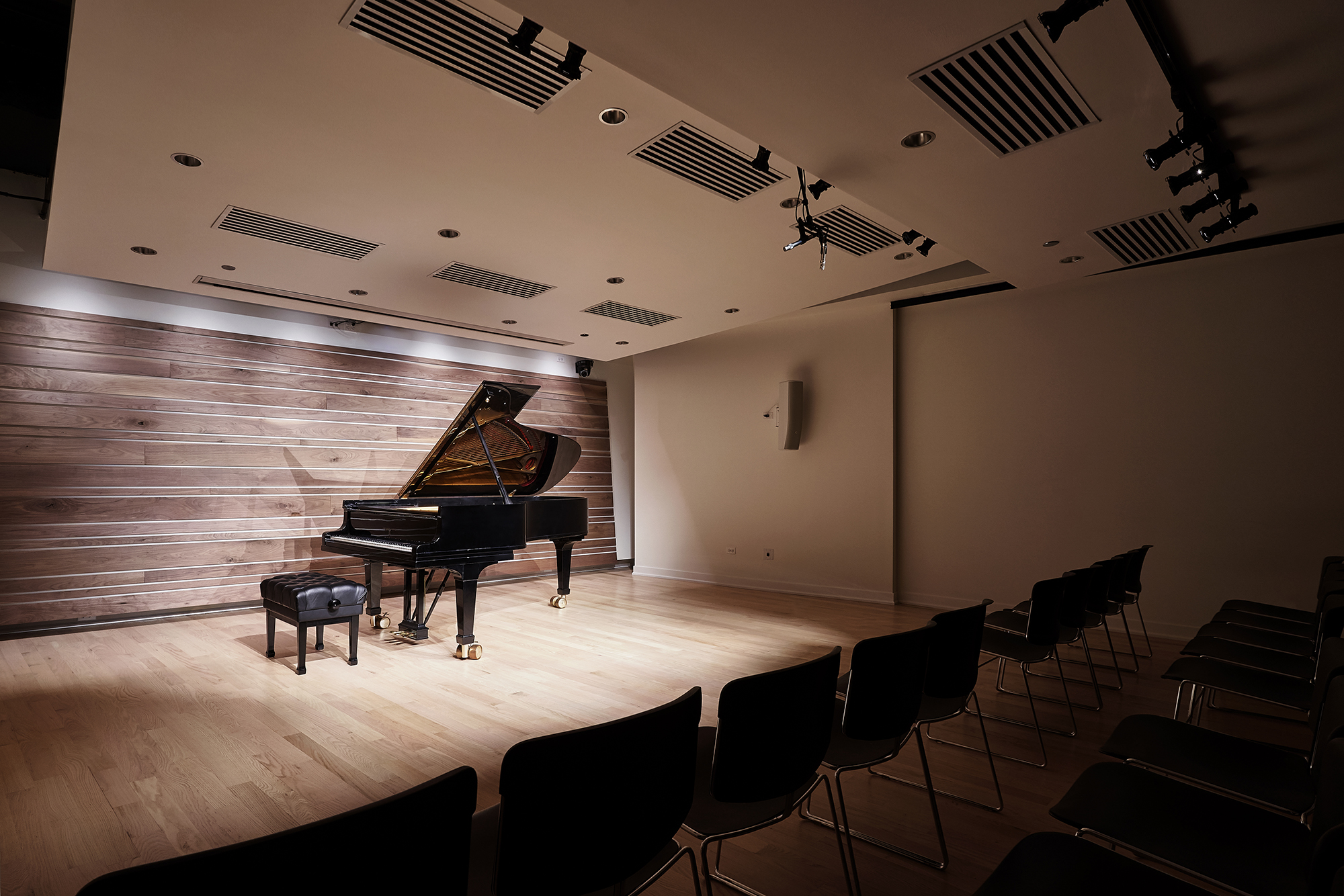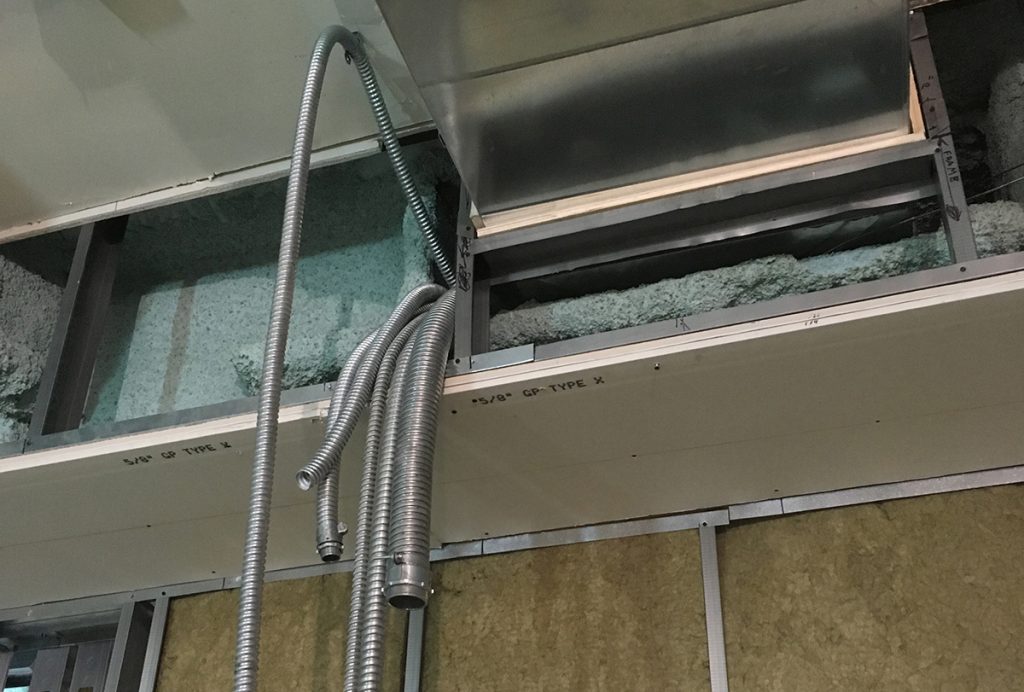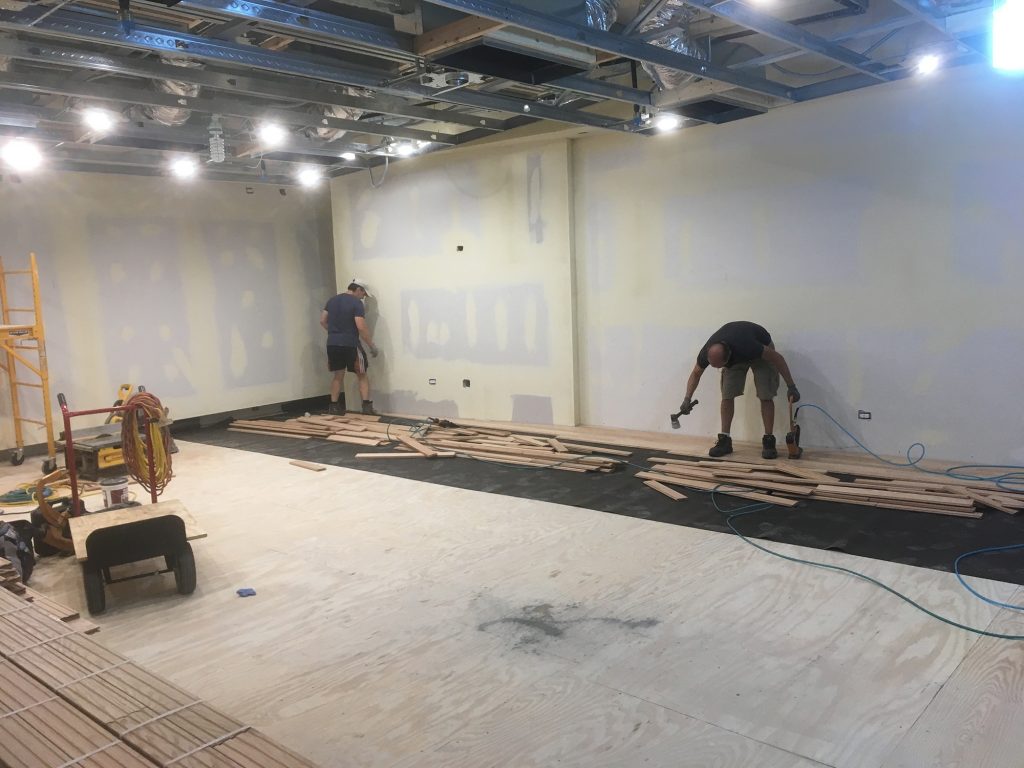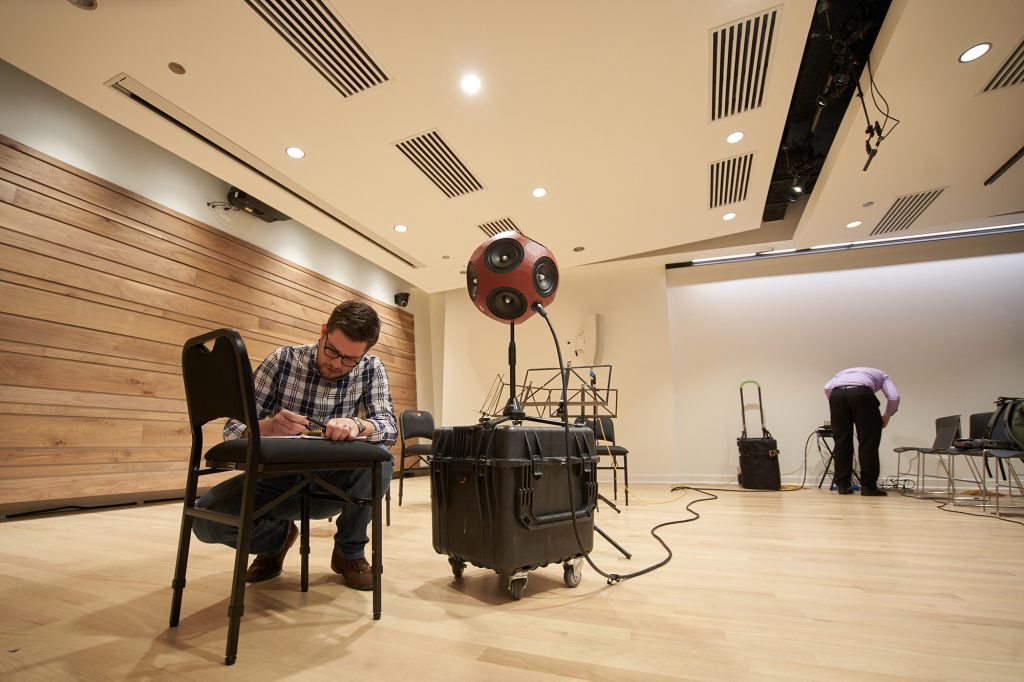
Guarneri Hall: Origin Story
Did you know that the story of Guarneri Hall’s origin involves a paradoxical vision, two office relocations, numerous construction challenges, and a pair of acoustical wizards? Keep reading to learn how.
A Predicament
In late 2007, Darnton & Hersh Fine Violins was faced with a predicament. The Federal Government was evicting all tenants in their building at 220 South State in downtown Chicago under eminent domain. Darnton & Hersh would have to vacate the building by the middle of the following year.
The best available option for a viable alternative space for Darnton & Hersh proved to be the top floor of a nearby building at 30 East Adams. The area was large, at 11,400 square feet, and had spectacular lake views, but the space was in poor condition and was offered for rent as-is. Darnton & Hersh would develop the perimeter of the floor into office and workshop space for their own use and for subtenants. What to do with the windowless central section of the building remained a question mark.
Digital What?
Meanwhile, in 2007, the first iPhone had only just been released. YouTube was still a relatively new platform and wouldn’t begin live streaming until the following year. But it was becoming clear that digital content was moving into the mainstream. One of the ideas for the central space was to convert it into a physical hub for a new organization whose mission would be the advancement of classical music through these emerging digital platforms. The area would be developed into a high-end audio/video recording and performance space for string players where this new, not-for-profit organization would present concerts to small live audiences and would produce digital content for distribution on the internet. It was a risky but intriguing idea.
Disaster Strikes
The Darnton & Hersh partners decided to take the gamble and try to realize the vision. In the summer of 2008, the company moved into their new suite and began the development of the planned recording and performance space on the same floor. However, almost immediately, problems emerged with the construction that stalled the project. Further disaster then struck on September 15th, 2008, when the financial services giant Lehman Brothers declared bankruptcy, triggering panic in global financial markets. With the economy in tatters, the performance space was put on hold and all but forgotten.
A Change of Plans

The partners had planned to stay in their space at 30 East Adams at least through the end of their lease in 2023. But in 2016, plans changed when developers bought out the existing tenant leases in order to convert the 30 East Adams building into residential apartments. Once again, the Darnton & Hersh partners were looking for a new home.
The need for a new office for Darnton & Hersh revived old opportunities. This time, the search for business space included the added intent to create a recording and performance space for a not-for-profit organization. After considering a few different options, a lease was drawn up at 11 East Adams. Cash from the sale of the lease at 30 East Adams would fund the build out of the recording and performance space. The room would be named after one of the most admired classic violin makers, Bartolomeo Giuseppe Guarneri “del Gesu” (1698-1744). And so, Guarneri Hall was born.
The Goal
As working musicians, the Darnton & Hersh partners had observed that most recording studios were acoustically dead and physically unsuited for live audiences. On the other hand, recording in live performance spaces can come with enormous, technical challenges. The goal for Guarneri Hall would be innovative, but seemingly straightforward — to create a resonant environment for both listening and recording, with optimized acoustics for stringed instruments, and able to accommodate an audience of 60. As it turned out, the concept would be far easier to describe than to execute.
Calling in the Pros
Darnton & Hersh recruited Carl Giegold of Threshold Acoustics to provide the acoustic design for Guarneri Hall. Previously, Carl had overseen the highly successful renovations to Nichols Hall in Evanston, in 2003. Bugaj Architects was selected to create the architectural drawings, and Schuler Shook took on the lighting design. M&K Contractors provided their experience and oversight for what proved to be a much more challenging undertaking than the team had anticipated. Although the project was relatively small in size by performance space standards, the construction challenges were substantial for every professional involved.

Box-in-box construction
Achieving quiet suitable for professional sound recording requires isolation of the critical space from vibration. Box-in-box construction is a well-proven method for achieving acoustic isolation: first, a perimeter wall is built, and then a second wall within, surrounded by a continuous 1″ gap between the two. The floor is installed on vibration dampening pads placed on the subfloor within the inner walls. The ceiling hangs from dampening springs attached to the ceiling substrate. All floor and ceiling connections are then closed with flexible sealant.
Heating and Air Conditioning: High volume = Low Velocity
Noise from heating and air conditioning creates unseen challenges for recording rooms. The ventilation must be overengineered in order to satisfy the room’s anticipated load with a low air velocity. Supply vents into the room must be rated for silence at the anticipated rate of airflow. As a further complication, all mechanicals into a sound-isolated room must be connected from the outside by flexible connectors. Meeting these technical design parameters requires skilled and experienced engineers and highly specialized materials vendors.
A Question of Geometry
Most of us take the behavior of sound for granted. Tiled showers are boomy, and carpeted rooms are dead. We expect to hear echoes in the mountains but not on flat prairies. Even most musicians evaluate sounds intuitively rather than based on a knowledge of acoustics.
Acousticians explain how and why sound behaves the way it does. Acoustic science has shown how the relationships between walls in a room profoundly affect how sound is perceived. For example, a highly undesirable flutter perceived in rooms with parallel walls is caused by what are known as standing waves. Smaller-sized rooms are highly prone to audible acoustic problems.
The available spaces for Guarneri Hall in downtown Chicago within the planned budget posed challenges to desirable ceiling heights. A relatively small space meant that the angles within the room had to be just right to avoid interference. The requirement of a secondary ceiling and a floating floor to properly isolate the space contributed to further challenges to ceiling height and overall room volume for the final plan. Threshold Acoustics’ design for Guarneri Hall had to meet these challenges.
Threshold Acoustics addressed the small room challenges with a canted stage-side wall, angled ceiling elements, and outward-angled side walls to avoid parallel surfaces and to aim the sound of the performers toward the audience side of the room.

A Tight Fit
Bringing mechanicals across the isolation gap in and out of the room turned out to be an unexpected problem. The building’s existing steel support beams were designed with integrated gaps for routing mechanicals. But the original design of the building had not anticipated the excess of ductwork and electrical cabling that would be required for this specialized project. In the end, every bit of available space in the gaps in the beams would be used.
Construction Challenges
The specialized work on a box-in-box construction project requires a very experienced general contractor and highly skilled tradespeople. It also requires a large amount of time and money for labor and materials. One cannot overstate the need for extreme attention to design and construction detail for such a project. From design to completion, Guarneri Hall took over two years to build. The design process began in earnest in late 2016, but the room wasn’t ready to host performances until late 2018.

An Emotional Milestone
As the project neared completion, it finally became possible to play music in the room. It was immediately apparent that all of the hard work and attention to detail, and Threshold Acoustics’’ thoughtful design work had paid off with surprising success. Guarneri Hall had turned out to be an ideal space for music.
Room geometry in action
One of the first big surprises was how correct the Threshold team had been about the effect of the angled ceiling elements and canted stage sidewall. Working musicians intuitively associate low ceilings with the sound of standing waves that are a normal consequence of close, parallel surfaces. As the ceiling elements were coming into place in Guarneri Hall, the low clearances created a sense of alarm. Would a room with a ceiling this low provide desirable acoustic performance? The Threshold team was confident that the effect would defy intuition because the ceiling and floor would not be parallel to one another, but rather would be angled to a carefully engineered degree to avoid interference. Threshold proved correct: ceiling heights and overall volume in the room have not presented problems.
Diffusion
Diffusion creates a scatter effect, breaking up the sound waves in ways that soften edges and minimize acoustic interference. Too little diffusion and a room can sound loud and raucous; too much, and sounds become blurry and unintelligible. Threshold Acoustic’s design for Guarneri Hall focused on applying just the right amount of diffusion through random-width boards of porous, unfinished walnut on the wall behind the stage, and through large panels of similar material arranged as chevrons on the back wall opposite the stage. The contractor waited to install the diffusion elements until after the room was otherwise complete, giving us the opportunity to experience the “before and after” effect in the space. The radical positive impact of the diffusion elements was another early surprise. When the chevrons on the back wall went up, the room suddenly seemed to become acoustically much larger.

Surprising versatility and range
Guarneri Hall was originally imagined for string players, in solo or small ensemble. It had seemed impossible to imagine that louder sounds from the piano and voice would be tolerable in a space of this size. But both piano and voice have proven to work beautifully in Guarneri Hall. Ensembles with as many as 14 musicians have found it manageable.
Unique Acoustical Intimacy
The biggest surprise has been the astonishing and unique intimacy of the live music experience in Guarneri Hall. The resonance, clarity, warmth, and immediacy of the space create a totally immersive experience for audiences. Guarneri Hall draws the listener into every nuance of a performance. Our performers can hold an audience’s attention with a whisper.

The Research Continues
In October of 2021, over three years after the opening of Guarneri Hall, the Threshold team returned with sophisticated gear to test the room. Their tests identified hollow sounds in the room at around 200hz, the lowest end of a violin and the mid-range of the cello. Independent of Threshold’s work, recording engineer Drew Schlegel of the Curtis Institute had corroboratively observed the same issue some months earlier and had successfully compensated for it by careful positioning of the sound-absorbing curtains built into the space. For acousticians, the study of the behavior of sound in a room never ends. And so Guarneri Hall has emerged as not only a wonderful recording and performance space but also as a laboratory for ongoing research into the behavior of sound waves.
A Work in Progress
More results of Threshold’s most recent observations may lead us toward further modifications to Guarneri Hall. Just as artists obsessively pursue greater heights in their output, so do the dedicated acousticians at Threshold Acoustics and the whole production staff at Guarneri Hall. All are forever striving for ways to continuously improve, for the benefit of the art.

